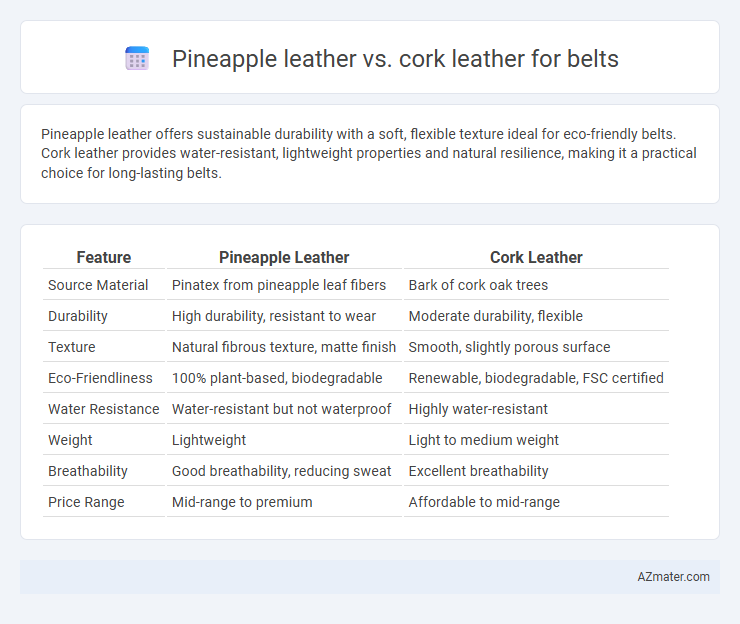Pineapple leather offers sustainable durability with a soft, flexible texture ideal for eco-friendly belts. Cork leather provides water-resistant, lightweight properties and natural resilience, making it a practical choice for long-lasting belts.
Table of Comparison
| Feature | Pineapple Leather | Cork Leather |
|---|---|---|
| Source Material | Pinatex from pineapple leaf fibers | Bark of cork oak trees |
| Durability | High durability, resistant to wear | Moderate durability, flexible |
| Texture | Natural fibrous texture, matte finish | Smooth, slightly porous surface |
| Eco-Friendliness | 100% plant-based, biodegradable | Renewable, biodegradable, FSC certified |
| Water Resistance | Water-resistant but not waterproof | Highly water-resistant |
| Weight | Lightweight | Light to medium weight |
| Breathability | Good breathability, reducing sweat | Excellent breathability |
| Price Range | Mid-range to premium | Affordable to mid-range |
Introduction to Pineapple Leather and Cork Leather
Pineapple leather, also known as Pinatex, is an innovative sustainable material made from pineapple leaf fibers, offering a cruelty-free and eco-friendly alternative to traditional leather. Cork leather, derived from the bark of cork oak trees, is highly durable, lightweight, water-resistant, and biodegradable, making it an excellent choice for environmentally conscious belt manufacturing. Both materials present unique textures and sustainable benefits, with pineapple leather showcasing a fabric-like feel and cork leather providing a natural, textured surface ideal for belts.
What is Pineapple Leather?
Pineapple leather, also known as Pinatex, is a sustainable alternative made from the fibers of pineapple leaves, offering an eco-friendly and cruelty-free option for belts. Unlike cork leather, which is derived from the bark of cork oak trees, pineapple leather provides a textured finish resembling traditional animal leather while supporting agricultural waste utilization. Its durability and lightweight properties make pineapple leather a popular choice for fashion accessories seeking a vegan and environmentally conscious material.
What is Cork Leather?
Cork leather is a sustainable, vegan alternative to traditional leather made from the bark of cork oak trees, primarily harvested in Portugal and Spain. Known for its lightweight, water-resistant, and durable qualities, cork leather provides excellent flexibility and a unique, natural texture ideal for belts. Unlike pineapple leather, which is derived from pineapple leaves, cork leather emphasizes eco-friendliness through renewable harvesting without damaging the trees.
Sustainability and Environmental Impact
Pineapple leather, made from the fibrous leaves of pineapple plants, offers a sustainable alternative by utilizing agricultural waste and reducing reliance on animal products, while cork leather, derived from the bark of cork oak trees, is renewable as the bark regenerates without harming the tree. Pineapple leather requires less water and fewer chemicals in processing compared to traditional leather, whereas cork leather production supports biodiversity and carbon sequestration due to cork oak forests' ecological benefits. Both materials minimize environmental impact by lowering carbon emissions and promoting circular economy principles through biodegradable and cruelty-free properties.
Durability and Strength Comparison
Pineapple leather, made from pinatex fibers, offers moderate durability with a resilient yet flexible texture suitable for belts, but it tends to wear faster under heavy use compared to cork leather. Cork leather, derived from cork oak bark, is renowned for its superior strength, water resistance, and abrasion resistance, making it a highly durable choice for belts that endure daily wear. Both materials provide eco-friendly alternatives to traditional leather, but cork leather surpasses pineapple leather in long-term durability and structural integrity.
Comfort and Wearability
Pineapple leather offers a soft, supple texture that molds comfortably to the skin, enhancing overall wearability for belts. Cork leather provides a lightweight, breathable material that resists moisture, making it ideal for extended use without irritation. Both materials deliver durable alternatives to traditional leather, with pineapple leather excelling in flexibility and cork leather excelling in natural water resistance.
Aesthetic Appeal and Design Options
Pineapple leather offers a smooth, consistent texture with a natural sheen that enhances sleek and modern belt designs, making it popular for fashion-forward aesthetics. Cork leather features a unique, grainy surface with earthy tones and natural patterns that provide a rustic, organic look ideal for casual and eco-conscious style choices. Both materials allow for versatile customization, but pineapple leather tends to accommodate finer detailing, while cork leather excels in bold, textured designs.
Maintenance and Care Guide
Pineapple leather requires gentle cleaning with a damp cloth and mild soap to preserve its delicate texture, avoiding harsh chemicals that can degrade the material. Cork leather is highly water-resistant and easy to maintain, needing only occasional wiping with a damp cloth to remove dirt and prevent cracking. Both materials benefit from avoiding prolonged sun exposure and storing belts in cool, dry places to extend their lifespan.
Price and Market Availability
Pineapple leather, often branded as Pinatex, commands a higher price due to its innovative production process and limited mass-market availability, positioning it as a premium option for belts. Cork leather is generally more affordable and widely accessible, benefiting from sustainable harvesting of cork oak bark and established supply chains. Both materials cater to eco-conscious consumers, but cork leather offers greater market availability and cost-effectiveness for belt manufacturing.
Which Leather is Best for Belts?
Pineapple leather offers a lightweight, vegan-friendly alternative with a soft texture and excellent breathability, making it ideal for stylish and comfortable belts. Cork leather stands out for its durability, water resistance, and natural hypoallergenic properties, providing a sturdy option for belts that endure daily wear and tear. Choosing between pineapple leather and cork leather depends on whether one prioritizes eco-friendly fashion with softness or long-lasting toughness and moisture resistance for belts.

Infographic: Pineapple leather vs Cork leather for Belt
 azmater.com
azmater.com